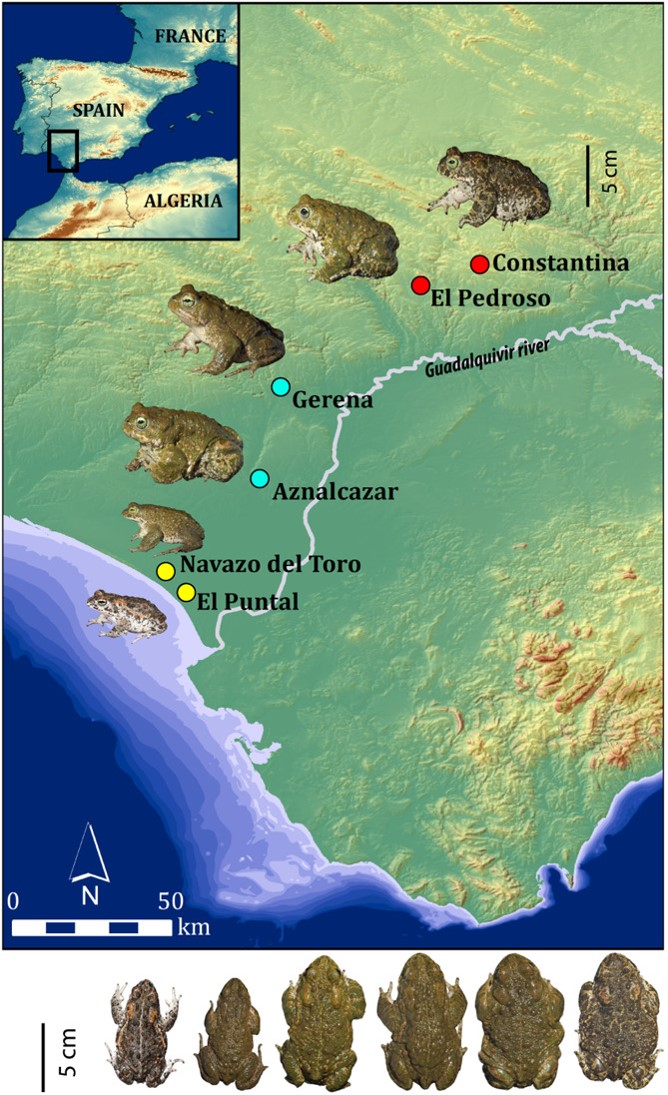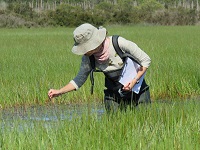Ample variation in body size is common in vertebrates over extensive geographical distances, or in isolated populations, where effective geographical barriers may cause dwarfism or gigantism. The potential causes of extreme size reduction in continental populations of amphibians within a short geographical distance and in the absence of geographical barriers were studied. Natterjack toads Epidalea calamita in Doñana National Park (Spain) experience up to 2.1?fold difference in body mass in as little as 37?km. Studying six populations divergent in body size, the genetic isolation of the dwarf populations using multilocus genotypes (16 microsatellites) was tested. Additionally, it was explored whether populations differed in trophic status (through stable isotope analysis), standard metabolic rate and growth pattern, senescence and age structure (conducting telomere length assays and skeletochronology). Advertisement calls were also recorded across populations and experimentally tested for behavioural reinforcement of the body size variation through female preferences. Local dwarfism in these populations occurs in the absence of genetic isolation while maintaining relatively high effective population sizes. Dwarf populations, however, were exposed to drier and warmer climatic conditions, have different trophic status, show lower mass?specific metabolic rate, and male advertisement calls with a higher dominant frequency. Juvenile growth differed among populations, reaching the adult stage at different body sizes. Altogether, these results suggest a significant influence of environmental conditions on the physiology and ecology of the Doñana E. calamita populations, mainly affecting toads between metamorphosis and sexual maturity. Further experimental and genomic studies focusing on these early life stages are necessary to dissect the relative roles of the environment and adaptive genetic differentiation on this phenomenon. informacion[at]ebd.csci.es: Hyeun-Ji et al (2020) Dwarfism in close continental amphibian populations despite lack of genetic isolation. OIKOS Doi 10.1111/oik.07086
https://onlinelibrary.wiley.com/doi/full/10.1111/oik.07086  Destacados
Destacados
Atrás
Dwarfism in continental populations of natterjack toads in the absence of genetic isolation
 Otros destacados
Otros destacados
 La Fundación Jaime González-Gordon ofrece cuatro becas para el desarrollo de Trabajos de Fin de Máster sobre Doñana
La Fundación Jaime González-Gordon ofrece cuatro becas para el desarrollo de Trabajos de Fin de Máster sobre Doñana
Las investigaciones se realizarán en colaboración y bajo el aval científico de la Estación Biológica de Doñana. La convocatoria está abierta hasta el 31 de enero.
 Cinco contratos para desarrollar la tesis doctoral en la Estación Biológica de Doñana - CSIC
Cinco contratos para desarrollar la tesis doctoral en la Estación Biológica de Doñana - CSIC
as posibles personas candidatas deben contactar con el IP del proyecto para discutir su interés. Para ser elegibles para uno de estos contratos, la persona candidata deberá tener título de máster,...
 Actividades de la Estación Biológica de Doñana en la Noche Europea de los Investigadores
Actividades de la Estación Biológica de Doñana en la Noche Europea de los Investigadores
Los días 29 y 30 de septiembre, los centros del CSIC de Sevilla celebrarán la Noche Europea de los Investigadores, un evento de divulgación científica que se celebra al mismo tiempo en casi 400...
 Inicio procedimiento nueva dirección EBD-CSIC
Inicio procedimiento nueva dirección EBD-CSIC
En la Junta de Instituto del pasado 20 de junio se aprobó el inicio del proceso de selección de una nueva dirección de la Estación Biológica de Doñana (CSIC).
— 5 Resultados por página



